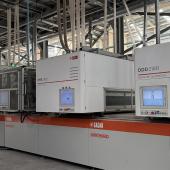Leading players in the industry attend the Sacmi Heavy Clay Meeting
The conference entitled "Meeting the future" organised by Sacmi last 28 september and held in the splendid setting of Poiano Resort Hotel in Garda (VR), where leading Italian and international experts discussed construction market trends, new scenarios and opportunities.
The speakers at the Sacmi meeting on the heavy clay industry, attended by more than 100 leading players in the sector, offered interesting insights and ideas.
The scars left by the 2009 crisis and the ability of manufacturers to meet the new challenges posed by Industry 4.0 were the key themes of the meeting opened by Heimo Scheuch, CEO of Wienerberger. Construction, observed Sheuch, is now an extremely dynamic market. Following the 2009 slump in volumes (falling by as much as 80% in some EU countries), the industry is now seeing signs of recovery both in Europe (driven by Germany, the UK and Poland) and worldwide, although in a context that is dramatically different from the pre-crisis years. “As manufacturers we must prove to the market that we’re capable of finding solutions based on innovation of both processes and products.”
Zero-impact and anti-seismic brick buildings without an ounce of reinforced concrete and urban redevelopment of both residential housing and historic city centres are just a few examples of the strategy to be pursued in the “7th construction cycle”, which Cresme believes is more than just a small recovery. “All the analyses point to global market growth of 50% over the next 20 years,” explained Lorenzo Bellicini, managing director of the Institute.
The symposium also explored the trends in the Italian and international markets.
In Italy, following the modest recovery of the industry (+2% in 2015, a trend confirmed in 2016) more than 70% of the market now consists of renovation and maintenance, while the new build segment is in steep decline.
Algeria, which along with the rest of North Africa acted as a real lifesaver for European producers during the years of the crisis, is expected to see a further surge in demand for advanced technologies and on-site training and support. “Although this market generates volumes of nearly 30 million tons a year (more than Spain and Italy in the boom years), local manufacturers are still facing considerable difficulties in finding technology partners and suitable personnel, so their volumes are well below potential production capacity,” said Luca Casaletti of Bongioanni Stampi.
Turkey, represented at the symposium by Gokhan Gorciz, Chairman of Tukder (Turkish brick and roof tile manufacturers’ association), is a country with a stable economy and steady growth which “will need at least 300 new kilns in the coming years to replace the current, largely outdated ones”, Gorciz explained inviting all those present to visit his homeland.
Xavier del Molino, deputy sales manager of Verdes, discussed the Russian market. “Russia is still paying for the consequences of the Ukraine crisis, while sanctions and the devaluation of the rouble have severely limited the country’s ability to convert initial expectations into concrete investment opportunities,” he said.
Despite a rapidly changing market and political instability, Argentina is by contrast experiencing a surge in demand for quality products and technologies for its steadily growing housing market. “Due to the adjustment of energy prices to international standards and new rules on building efficiency, it is essential for us to achieve further growth in terms of both technology and products,” explained Angel Di Benedetto from Latercer Group, a player that holds an almost two-thirds share of the domestic market. This means new, denser bricks and new composite materials for what will always remain the most environmentally friendly, durable and versatile of building materials.
Did you find this article useful?
Join the CWW community to receive the most important news from the global ceramic industry every two weeks




















